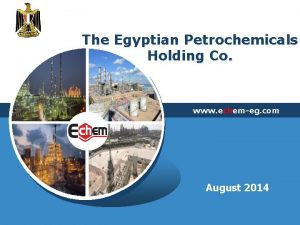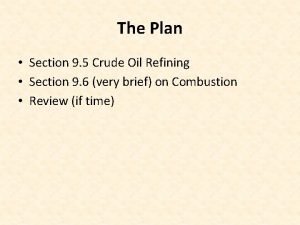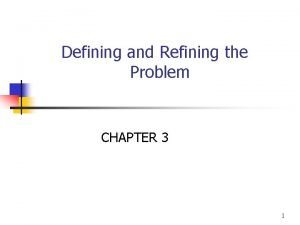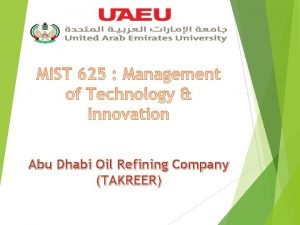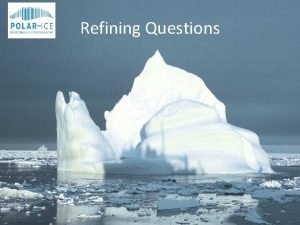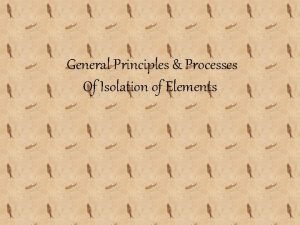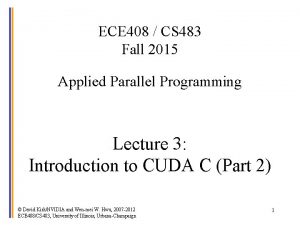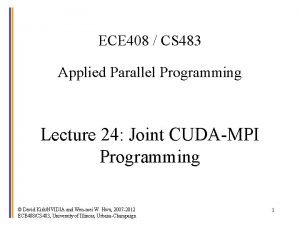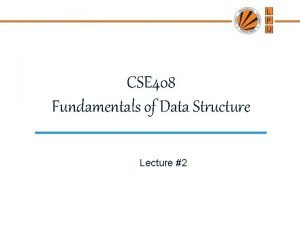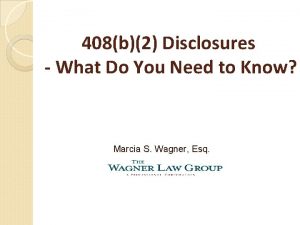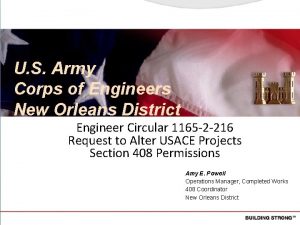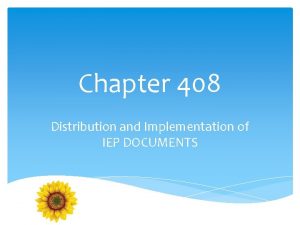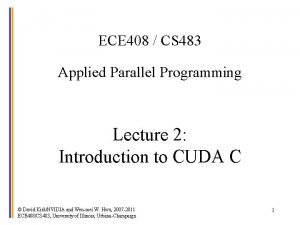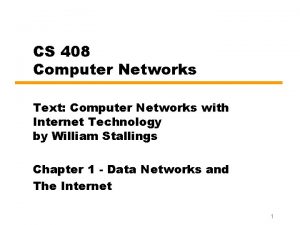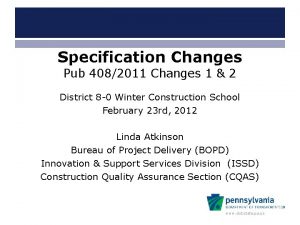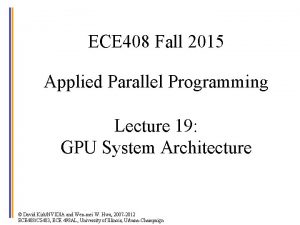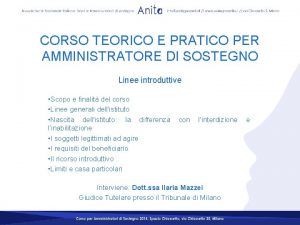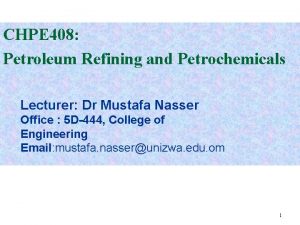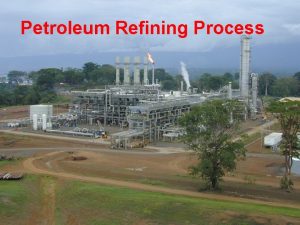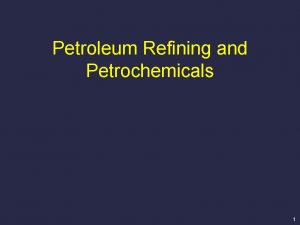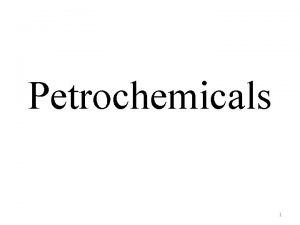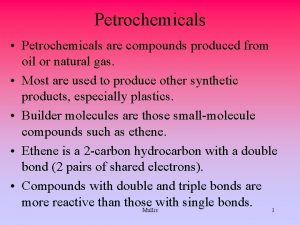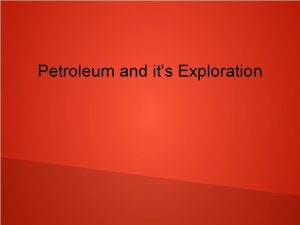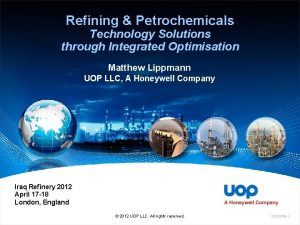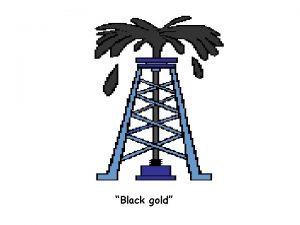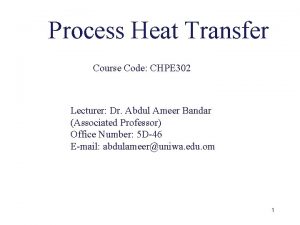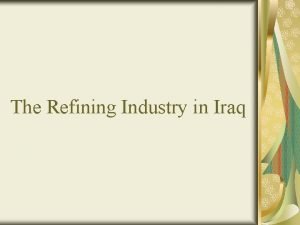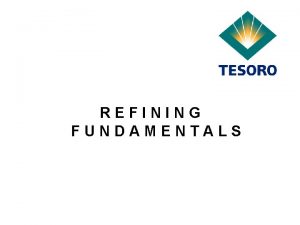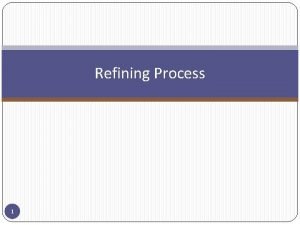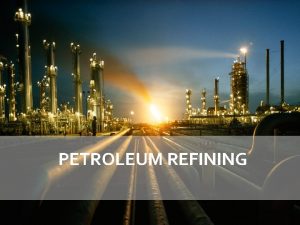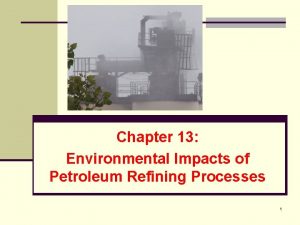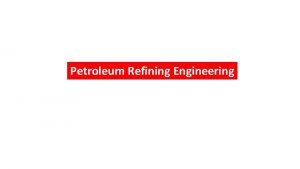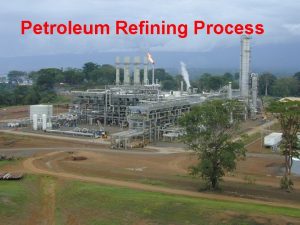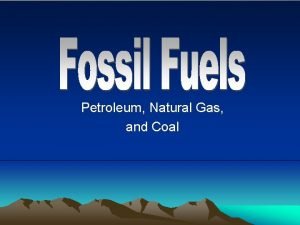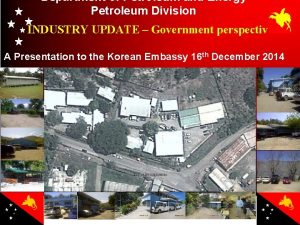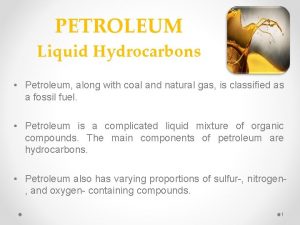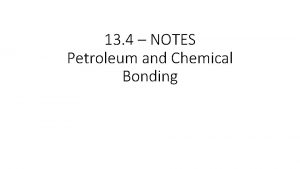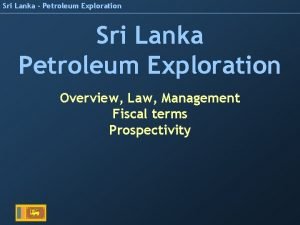CHPE 408 Petroleum Refining and Petrochemicals Lecturer Dr



































- Slides: 35

CHPE 408: Petroleum Refining and Petrochemicals Lecturer: Dr. Mustafa Nasser Room : 33 -12, College of Engineering Email: mustafa. nasser@unizwa. edu. om

Course objectives n This course highlights the role of an oil refinery in converting crude oil physically and chemically into useful everyday products like petrol, diesel, lubricating oil, fuel oil and bitumen.

Course objectives Petroleum Refinery Petroleum Feedstock (Crude oil) Petroleum Products LPG Naphtha Jet fuel Gasoline Kerosene Diesel fuel Asphalt base


CONTENTS 1. Introduction to petroleum Refining Theory of petroleum origin, Oil Well, chemical composition of crude oil, types of crude and crude oil production. 2. Crude oil characterisation Chemistry of petroleum, properties of crude oil such as: API, Pour points, Carbon residues, salt content, Characterization factor, Aniline point, Nitrogen and Metal contents. Finally TBP curve.

CONTENTS 3. Refinery Products Refinery major products families, i. e. gasoline, diesel, jet fuel, and fuel oils. Also this section covers theories of Octane number and Cetane number and the crude oil upgrade (blending) processes. 4. Separation unit First part cover the pre-treatments processes such as dehydration, desalting absorbers drying process. Second part covers Distillation analysis, types of distillation used, and vacuum distillation for crude oils.

CONTENTS 5. ASTM, TBP and EFV calculations This section covers: ASTM, TBP and EFV curves calculation. Conversion procedures from one type to the others types will be highlighted 6. Cracking Processes The main processes involved in the area of Solvent Deasphalting, Thermal cracking, Hydro cracking, Coking Catalytic cracking 7. Reforming Processes This section covers: the main processes involved in the Reforming Alkylation, Polymerization, and Isomerisation.

CONTENTS 8. Blending Processes This section covers: theory behind the blending process, blending calculation and optimisation and finally refinery integration. 9. Treatment Processes This section covers: the main processes involved in the Hydrotreatment, Sulfur recovery, and Amine recovery. 10. Cocking and Thermal Processes This section covers: the main processes involved in the coking, Visbreaking (thermal cracking), Delayed Coking, and Flexi-coking

CONTENTS 11. Lube oils Syntheses This section covers: Types of lube oils, lube oil properties, lube oil flow sheet, synthetic oil properties and production 12. Petrochemicals This section covers: Petrochemical overview, the main processes involved in the production , conversion, and treatment of olefins, aromatics 13. Environmental Aspects This section covers: The environmental aspects in many refinery units such as desalting unit, distillation, thermal cracking, cocking , FCC, Catalytic reforming Hydro-treating , waster water treatment, and Air emission.

Course Learning Outcomes Successful students in this course can: n Understand fundamental technology behind the modern refinery of petroleum n Analyse the role of a chemical engineer in the petroleum processing industry n Use theory learned in this course for design of petroleum processing plants n Plan and carry out logistics, economical and environmental matters in refineries to achieve optimisation.

References n n Speight, J. G. , The Chemistry and Technology of Petroleum, Marcel Dekker Inc. , Third Edition, 1999. ISBN 0 -8247 -0217 -4. Jones, D. S. J. , Elements of Petroleum Processing, John Wiley, 1995. ISBN 0 -47195254 -0. Mc. Ketta, J. J. , Petroleum Processing Handbook, Marcel Dekker Inc. , 1992. ISBN 08247 -8681 -5. Online resources.

Assessments Quizzes: Projects: Mid term one: Mid term Two: Final exam: (10%) (20%) (15%) (40%)

Assignment format n The student required to submit the hard copy of the assignment. The hard copy should not exceed 10 pages A 4 size, including front page, appendices, etc. ). The text should be made in 12 pt font using Times New Roman style with 1. 5 line spacing. Finally, references should be written in standard scientific way (check the literature).

Reviewing Procedure n A peer review practice will be applied to all presentations. The student should submit their presentation 2 days in advance to the reviewing group. The reviewing group should meet and submit not more than 1 page of comments and recommendations. The student should take action on these comments by revising their presentation based on these comments.

What is Petroleum (Crude oil)? Crude oil, is a very complex mixture of compounds composed of (mainly) carbon, hydrogen, oxygen, nitrogen, and sulfur. Crude oils are made of the following elements/ compounds: n Carbon - 84% n Hydrogen - 14% n Sulfur - 1 to 3% (hydrogen sulfide, sulfides, disulfides, elemental sulfur) n Nitrogen - less than 1% (basic compounds with amine groups) n Oxygen - less than 1% (found in organic compounds such as carbon dioxide, phenols, ketones, carboxylic acids) n Metals - less than 1% (nickel, iron, vanadium, copper, arsenic) n Salts - less than 1% (sodium chloride, magnesium chloride, calcium chloride) v. Of these elements, carbon and hydrogen are the major components.

What is Petroleum (Crude oil)? q Linked together with inter-atom bonds, these CH compounds form different kinds of molecules of many different shapes and sizes. q Collectively, these carbon-hydrogen compounds are referred to as "hydrocarbons. “ Ø The smallest hydrocarbons are gaseous at ordinary room temperature. Ø The somewhat larger hydrocarbon molecules are liquids, Ø whereas the largest are solids. q In crude oil, all these different kinds of molecules are "dissolved" in each other -- making for a rather unpleasant looking and smelling mess.

What is Petroleum (Crude oil)? q In the refinery, the various "fractions" of the crude oil (gases, liquids, and solids) are separated from each other (and sometimes modified in composition) before they are distributed for use. q The liquid fractions are primary components of gasoline, diesel fuel, and lubricating and heating oils. The very large hydrocarbon components are solids at room temperature and are used for roofing and road surfaces -- tar and asphalt.

How was oil formed? q Oil was formed from the remains of animals and plants (diatoms) that lived millions of years ago in a marine (water) environment before the dinosaurs. Over millions of years, the remains of these animals and plants were covered by layers of sand silt. Heat and pressure from these layers helped the remains turn into what we today call crude oil. The word "petroleum" means "rock oil" or "oil from the earth. "

How was oil formed? q Crude oil is a smelly, yellow-to-black liquid and is usually found in underground areas called reservoirs. q Scientists and engineers explore a chosen area by studying rock samples from the earth. Measurements are taken, and, if the site seems promising, drilling begins. Above the hole, a structure called a 'derrick' is built to house the tools and pipes going into the well. When finished, the drilled well will bring a steady flow of oil to the surface.


What Fuels Are Made From Crude Oil? What Fuels Are Made from Crude Oil? q After crude oil is removed from the ground, it is sent to a refinery by pipeline, ship, or barge. q At a refinery, different parts of the crude oil are separated into useable petroleum products. Crude oil is measured in barrels (abbreviated "bbls").

What Fuels Are Made From Crude Oil? q One barrel of crude oil, when refined, produces about 19 gallons of finished motor gasoline, and 10 gallons of diesel, as well as other petroleum products

Chemical Composition of Crude Oil n crude oil can be divided into three groups, which are q q q n paraffins, napthenes aromatics. It is commercially divided into two kinds, q q the heavy, or lubricating oil, and the light oil.

Types of crude n n n Major Type Based on Geography q Far Eastern q Middle Eastern q North Sea q Others The formation conditions - never identical. Known crudes > 100 Countries producing crude > 48 Most important area for crude – Middle East Saudi Arabia - 26% world reserve

Crude Oil Reserves

Crude oil Production

Crude oil: physical characteristics Colour: Dark Red, Brown, Black Viscosity: From As Fluid As Water to Tar-Like Odour: From Nil to Rotten Eggs Pour Point: 0 deg F to 100 deg F Density: 0. 8 - 1. 0 g/cc

Table 1: Composition of typical petroleum samples. Element Natural gas/weight% Crude oil/weight% Bitumen/weight% carbon 65. 0– 80. 0 85. 0 80. 2 hydrogen 20. 0– 25. 0 12. 0 7. 5 oxygen trace >2. 0 7. 6 nitrogen 1. 0– 15. 0 >1. 5 1. 7 sulphur >0. 2 >3. 0 q The composition of crude oil does not only vary between different fields, it is also likely to vary by depth and between different wells in the same field.

Crude oil Chemical Composition Hydrocarbon n q q n Collection of carbon and hydrogen molecules C 1 to C 360 in Different Molecular Structure Major classes/ “families” in crude oil: q Paraffins q Naphthenes q Aromatics q Olefins

Refinery n Organised and coordinated arrangement of manufacturing process to provide physical & chemical change of crude oil

The refining process Every refinery begins with the separation of crude oil into different fractions by distillation. v The fractions are further treated to convert them into mixtures of more useful saleable products by various methods such as; q Cracking q Reforming q Polymerisation q. Alkylation q Isomerisation v These mixtures of new compounds are then separated using methods such as; q Fractionation q Solvent extraction v Impurities are removed by various methods, e. g. q Dehydration q Sulphur removal q Desalting q Hydrotreating


Petroleum products n There are specifications for over 2000 refinery products

Petroleum products

Units 35
 Lecturer's name
Lecturer's name Amreya petroleum refining company
Amreya petroleum refining company Mnemonic for fractional distillation of crude oil
Mnemonic for fractional distillation of crude oil Petrochemicals
Petrochemicals Cpq petrochemicals industry
Cpq petrochemicals industry Identify a broad problem area examples
Identify a broad problem area examples Takreer company
Takreer company Refining discussion techniques
Refining discussion techniques Short note on vapour phase refining
Short note on vapour phase refining Jeannie watkins
Jeannie watkins Spe distinguished lecturer
Spe distinguished lecturer Good afternoon teacher and my friend
Good afternoon teacher and my friend Photography lecturer
Photography lecturer Lecturer in charge
Lecturer in charge Designation lecturer
Designation lecturer Designation of lecturer
Designation of lecturer Guest lecturer in geography
Guest lecturer in geography Lecturer name
Lecturer name Pearson lecturer resources
Pearson lecturer resources Spe distinguished lecturer
Spe distinguished lecturer Lector vs lecturer
Lector vs lecturer Lecturer in charge
Lecturer in charge Cfa lecturer handbook
Cfa lecturer handbook Lecturer asad ali
Lecturer asad ali Uiuc cs 483
Uiuc cs 483 Ece 408
Ece 408 Cse408
Cse408 408b2 form
408b2 form Usace section 408
Usace section 408 Nyc doe chapter 408 forms
Nyc doe chapter 408 forms Ece 408
Ece 408 Cs 408 sabancı
Cs 408 sabancı Pub 408
Pub 408 Ece 408
Ece 408 Ece408
Ece408 Art 408 cc
Art 408 cc

